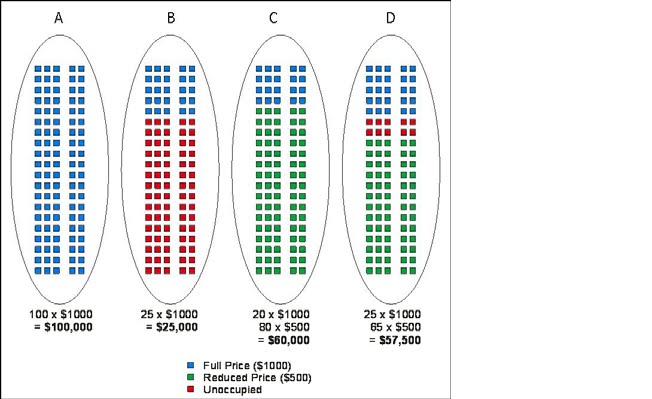Spas are complex operations that require skill, resources and planning to manage successfully. In this post, we show you how to boost revenue by making the most of your spa’s resources. Just follow these three practical steps and you’ll soon notice an increase in revenue.
1. Be flexible with your pricing
Avoid being rigid about your pricing policy. Be flexible and adapt your prices to your different types of clients and to different times of the day. In terms of your print collateral, you can add off peak and peak pricing to your price list so that guests know when they pay full price and when they don’t. Alternatively, you can insert a small note to inform guests that during a certain time period, they can enjoy a discount on all treatments. This would work like the ‘Happy Hours’ do in bars.
Divert traffic from your peak hours to your off peak hours: diverting traffic is always preferable to having to turn down clients. The airline industry offers a useful example of how to do this effectively. They are extremely successful at optimizing revenue (also known as ‘yield management’). If you book your holiday or airline ticket months in advance, you will get a cheaper price. If you book during peak period, Christmas, summer, and so on, you’ll pay a higher price.
There is no reason why your spa should do business in a different way to the airline industry. There will be clients who are price sensitive and won’t mind having their treatment at a less favourable time so long as they get a decent discount. Your price insensitive client or the client who is time constrained won’t mind paying the full price for a treatment, but it would need to be at peak time.
2. Know your “star” treatments
Choosing the different therapies, treatments and services of your spa is a complex undertaking. To do it successfully, you need to apply the principles of ‘treatment menu engineering’. This involves a careful analysis of your treatment and service offering as well as your customer mix.
To effectively engineer your menu, study your treatments sold on a regular basis. Know which are your best-selling treatments, which ones give you the most margin, and also those that are not doing so well.
To give you a greater level of insight, take all the treatments in your menu and divide them into four different sections that will provide you with a clearer idea of the level of sales and the overall impact of the different treatments and services in your bottom line:
- Stars: The group of treatments that have low cost of sales but are strong sellers
- Plow horses: Treatments and services with a high cost of sale but at the same time are strong sellers too
- Puzzles: Treatments where the demand is not too strong but where the cost of sale is also low
- Dogs: These are your high cost of sale treatments that sell poorly
Adapt your treatment menu according to customer actions. There is no point keeping on your treatment menu treatments that your clients are not buying – particularly dogs. Sell your clients what they want to buy and not what you want to sell.
Your treatment menu should be updated every few months to cater to the evolving wellness and beauty needs of your clients. However, avoid drastic changes your treatment menu all at once. It can have negative effects on the perceived experience of your regular customers.
For more information about treatment menu engineering, see How to open a spa: Part 4 – writing of the treatment and services menu.
3. Be dynamic about staff scheduling
Your staff is your number one asset. Without good qualified staff, your spa will not be a success. However, most spa managers complain that they do not have enough staff, especially during peak times. This means they need to turn down clients.
The idea behind dynamic scheduling is to optimize the number of therapists you have. One of the main challenges spas have is predicting demand levels. Sometimes, when you think your spa is going to be quiet, it turns out to be extremely busy. Equally, when you think your spa is going to be busy, it turns out to be very quiet. So instead of having four therapists doing nothing, or giving them downtime duties (such as deep cleaning, stock take, and so on), send some of them home. They’ll be happy too.
Some spas have expanded this idea further: they are now creating a ‘hour bank’ and appointing therapists ‘on call’. Depending on times of the month, the therapist ‘owes’ hours to the spa, or the spa owes the therapist ‘overtime’. Instead of being paid overtime, therapists can also choose to have a day off instead of using one of their holiday dates.
How can dynamic scheduling help your spa?
- You have a higher control of your staffing schedule
- You have therapists when you need them (due to the on call system)
- Your therapists are happy as they don’t feel overworked and they remain motivated – sitting around and doing nothing is a drain of general team motivation
- Your spa don’t incur huge overtime pay
- Your therapists are more engaged and willing to help
This blog post offers a concise introduction to the topic of optimising your spa’s performance. For a more in-depth look at this subject, see this presentation on revenue management by top spa business specialist Sonal Uberoi.
Los spas son negocios complejos que requieren habilidades, recursos y planificación para gestionarlos con éxito. En este artículo, le mostraremos cómo aumentar los ingresos aprovechando los recursos de su spa. Sólo siga estos tres prácticos pasos y pronto se percatará de que los ingresos aumentan.
1. Sea flexible con sus precios
Evite políticas de precios estrictas. Sea flexible y adapte sus precios a sus diferentes tipos de clientes y a cada momento del día. En lo que se refiere a sus materiales impresos, puede agregar precios de horas punta y de horas valle a la lista de precios para que sus clientes sepan cuando pagan el precio completo y cuando no. Como alternativa, puede añadir una pequeña nota informando a los clientes de que durante un determinado periodo de tiempo, pueden disfrutar de un descuento en todos los tratamientos. Esto funcionaría como las “Happy Hours” en los bares.
Derive la afluencia de clientes de las horas punta a las horas de más baja afluencia: desviar la afluencia es siempre preferible a tener que rechazar clientes. La industria aérea ofrece un ejemplo útil de cómo hacer esto de manera efectiva dado que ha tenido mucho éxito en la optimización de ingresos (también conocida como “gestión del rendimiento”). Si reserva sus vacaciones o los billetes de avión con meses de antelación, obtendrá un precio más barato. Si los reserva durante la temporada alta, Navidad, verano, etc., tendrá que pagar un precio más alto.
No hay ninguna razón por la cual su spa tenga que hacer negocio de manera diferente al sector del transporte aéreo. Habrá clientes susceptibles a los precios a quienes no les importe recibir su tratamiento en una hora menos conveniente, siempre y cuando obtengan un descuento decente. A sus clientes no susceptibles al precio o los clientes que tienen limitaciones de tiempo no les importará pagar el precio completo de un tratamiento, pero tendrá que ser durante una hora punta.
2. Sepa cuáles son sus tratamientos ‘estrella’
Escoger las terapias, tratamientos y servicios de su spa es una tarea compleja. Para hacerlo correctamente, es necesario aplicar los principios de la “ingeniería de los menús de tratamientos”. Esto implica un análisis cuidadoso de sus tratamientos y su oferta de servicios, así como de su mezcla de clientes.
Para diseñar con eficacia su menú, estudie los tratamientos que se venden regularmente. Conozca cuáles son sus tratamientos más vendidos, cuáles le dan más margen de beneficios y aquellos que no se venden tan bien.
Para obtener una visión más completa, divida todos los tratamientos de su menú en cuatro apartados diferentes que le proporcionarán una idea más clara del nivel de ventas y el impacto general de los diferentes tratamientos y servicios en su balance final:
- Estrellas: grupo de tratamientos de bajo precio de venta pero que son de los más vendidos
- Caballos de arado: tratamientos y servicios de precio alto pero que, al mismo tiempo, se venden bien
- Rompecabezas: Tratamientos de poca demanda, pero que su costo de venta también es bajo
- Perros: Estos son los tratamientos de alto costo que se venden mal
Adapte su menú de tratamientos según las acciones de los clientes. No tiene sentido mantener en el menú tratamientos que sus clientes no compran – especialmente los del tipo perro. Venda a sus clientes lo que quieren comprar y no lo que usted quiere vender.
Debe actualizar su menú de tratamientos cada pocos meses para atender a las cambiantes necesidades de belleza y bienestar de sus clientes. Sin embargo, evite hacer cambios drásticos en su menú de tratamientos. Puede tener efectos negativos sobre la percepción de la experiencia por parte de sus clientes regulares.
Para más información acerca de la ingeniería de los menús de tratamientos, lea este artículo.
3. Mantenga los horarios del personal dinámicos
Su personal es su principal activo. Sin un personal bien cualificado, su spa no tendrá éxito. Sin embargo, la mayoría de los gerentes de spa se quejan de que no tienen suficiente personal, especialmente durante las horas punta. Esto significa que deben rechazar clientes.
La idea detrás de unos horarios dinámicos es optimizar el número de terapeutas que usted tiene. Uno de los retos principales de los spas es predecir los niveles de demanda. A veces, cuando cree que el spa va a estar tranquilo, acaba estando muy ocupado. Igualmente, cuando cree en su spa va a estar ocupado, resulta estar muy tranquilo. Así que en vez de tener cuatro terapeutas sin hacer nada o dándoles funciones de tiempo de inactividad (como tareas de limpieza profunda, inventarios, etc.), envíe a algunos de ellos a casa. A ellos también les parecerá bien.
Algunos spas han expandido esta idea todavía más: están creando un “banco de horas” y designando a terapeutas “de guardia”. Dependiendo de las diferentes partes del mes, el terapeuta “debe” horas para al spa o el spa debe al terapeuta “horas extras”. En lugar de pagar horas extras, los terapeutas también pueden optar por disfrutar de un día de descanso en lugar de utilizar uno de sus días de vacaciones.
He aquí algunas maneras cómo una planificación dinámica ayudará a su spa:
- Usted tendrá un mayor control de su plantilla de personal
- Dispondrá de terapeutas cuando los necesite (debido al sistema de guardias)
- Sus terapeutas estarán contentos, ya que no se sentirán sobrecargados de trabajo y permanecerán motivados – permanecer sentados sin hacer nada drena la motivación general del equipo
- Su spa no incurrirá en un enorme pago de horas extras
- Sus terapeutas estarán más comprometidos y dispuestos a ayudar
Esta publicación ofrece una introducción concisa al tema de la optimización del rendimiento de su spa. Para obtener información más detallada sobre este tema, consulte esta presentación sobre la gestión de ingresos por una de las principales expertas en spas, Sonal Uberoi.




